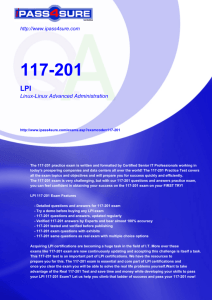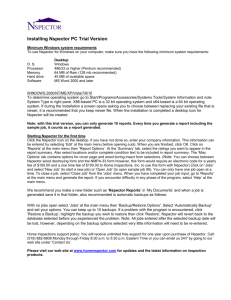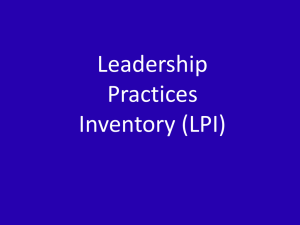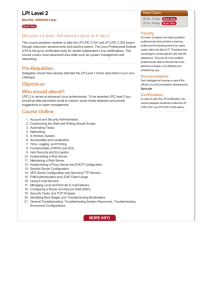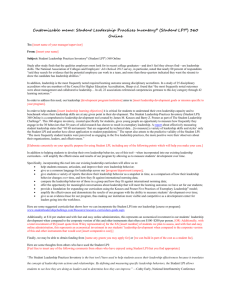117-201 LPI Linux-Linux Advanced Administration Thousands of IT
advertisement
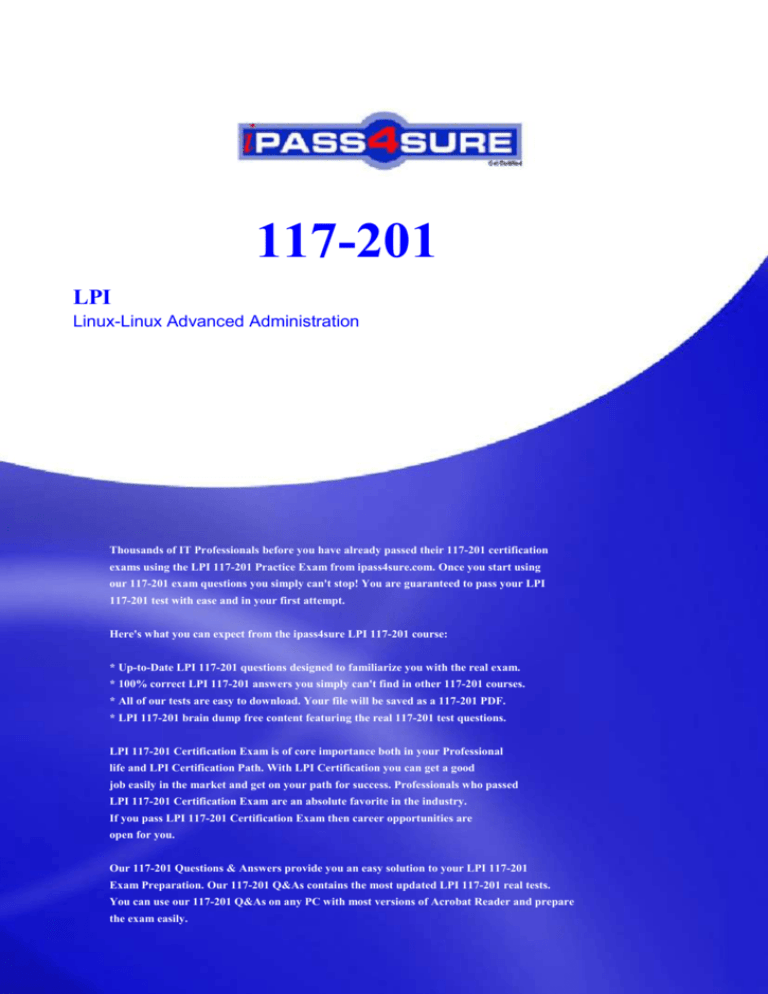
117-201 LPI Linux-Linux Advanced Administration Thousands of IT Professionals before you have already passed their 117-201 certification exams using the LPI 117-201 Practice Exam from ipass4sure.com. Once you start using our 117-201 exam questions you simply can't stop! You are guaranteed to pass your LPI 117-201 test with ease and in your first attempt. Here's what you can expect from the ipass4sure LPI 117-201 course: * Up-to-Date LPI 117-201 questions designed to familiarize you with the real exam. * 100% correct LPI 117-201 answers you simply can't find in other 117-201 courses. * All of our tests are easy to download. Your file will be saved as a 117-201 PDF. * LPI 117-201 brain dump free content featuring the real 117-201 test questions. LPI 117-201 Certification Exam is of core importance both in your Professional life and LPI Certification Path. With LPI Certification you can get a good job easily in the market and get on your path for success. Professionals who passed LPI 117-201 Certification Exam are an absolute favorite in the industry. If you pass LPI 117-201 Certification Exam then career opportunities are open for you. Our 117-201 Questions & Answers provide you an easy solution to your LPI 117-201 Exam Preparation. Our 117-201 Q&As contains the most updated LPI 117-201 real tests. You can use our 117-201 Q&As on any PC with most versions of Acrobat Reader and prepare the exam easily. Question: 1 Which two utilities can you use to set up a job to run at a specified time? A. at and crond B. at run and crontab C. at and crontab D. atd and crond Answer: C Explanation: The ‘at’ command is used to execute commands at a specified time and optional date. A cron job is a program or script scheduled at a specified time. The ‘crontab’ program is used to create user cron jobs. Reference: http://www.oreillynet.com/linux/cmd/a/at.html http://www.oreillynet.com/linux/cmd/c/crontab.html Incorrect Answers. A: The Cron daemon (crond) is the program that runs the cron job at the specified time. It is not used to set up a cron job. B: At run is used to run jobs scheduled by the ‘at’ program. It is not used to set up a job to run at a specified time. D: Atd is the ‘at’ deamon. Similar to the cron daemon, the program runs the jobs scheduled with the ‘at’ command. Question: 2 After creating a backup of the users home directories called backup.cpio you are asked to restore a file called memo.ben. What command should you type? A. cpio –iF backup.cpio memo.ben Answer: A Explanation: The ‘cpio’ command is used to create backups or restore files from a backup. The –i option is to extract something. The F option is to specify a file. Here we are extracting memo.ben from a file named backup.cpio. Reference: http://www.oreillynet.com/linux/cmd/c/cpio.html Question: 3 You wish to restore the file memo.ben which was backed up in the tarfile MyBackup.tar. What command should you type? A. tar xf MyBackup.tar memo.ben Answer: A Explanation: Tarfiles are created using the ‘tar’ utility. Therefore, you should use the ‘tar’ utility to extract the files. The x option is to extract and the f option is to specify a filename to extract from. Page 1 of 84 Reference: http://www.oreillynet.com/linux/cmd/t/tar.html Question: 4 When is the most important time to restore a file from your backup? A. On a regular scheduled basis to verify that the data is available. B. When the system crashes. C. When a user inadvertently loses a file. D. When your boss asks to see how restoring a file works. Answer: A Explanation: According to ‘best practice’, you should regularly restore files to verify that your backup procedures are working. It’s no good backing up files regularly if you are unable to restore files when needed. Incorrect Answers: B: When the system crashes, you may need to restore your whole system. However, this shouldn’t be the only time you restore files. C: When a user loses a file, it will need to be restored. However, you should prepare for this eventuality by regularly testing your backup/restore process to ensure you are able to restore a file when needed. D: When your boss asks to see how restoring a file works, you want it to work when you show him. This is why you should test your backup/restore processes. Question: 5 Which one of the following factors does not play a role in choosing the type of backup media to use? A. How frequently a file changes. B. How long you need to retain the backup. C. How much data needs to be backed up. D. How frequently the backed up data needs to be accessed. Answer: A Explanation: Your choice of backup media will depend on its capacity, its shelf life and the time it takes to access the data. The frequency of file changes is irrelevant. Incorrect Answers: B: Different backup media can be kept for varying periods of time. You should find out from the manufacturers how long a backup media can be kept without losing its data. C: Obviously, your choice of backup media will depend on the amount of data to be backed up. For example, a CD-ROM can hold around 700MB of data while tapes can hold up to hundreds of gigabytes of data. D: Your choice of backup media will also depend on the time it takes to retrieve data from the media. Reading data from a CD-ROM or DVD is much quicker than reading data from a tape. Question: 6 You attempt to log out but receive an error message that you cannot. When you issue the jobs Page 2 of 84 command, you see a process that is running in the background. How can you fix thus so that you can logout? A. Issue the kill command with the PID of each running command of the pipeline as an argument. B. Issue the kill command with the job number as an argument. C. Issue the kill command with the PID of the last command as an argument. D. Issue the kill command without any arguments. Answer: C Explanation: The kill command is used to send a signal to kill one or more process IDs. You must own the process or be a privileged user, otherwise the kill command will be ignored. Reference: http://www.oreillynet.com/linux/cmd/k/kill.html Incorrect Answers A: You need to end the background process. You know its process ID; therefore you should issue the process ID with the kill command to kill the appropriate process. B: You cannot use the job number with the kill command. You should use the process ID or process name. D: The kill command won’t work if it doesn’t know what process you want it to kill. Question: 7 The top utility can be used to change the priority of a running process? Another utility that can also be used to change priority is_______? A. nice Answer: A Explanation: The ‘nice’ command enables you to run a command with a different priority. Nice –n <adjustment> command, increments the priority of ‘command’ by <adjustment>. You can increase the priority of a command my specifying a negative adjustment. For example, ‘nice –n-5 command’ will run ‘command’ with the priority increased by 5. Reference: http://www.oreillynet.com/linux/cmd/n/nice.html Question: 8 You need to search the entire directory structure to locate a specific file. How could you do this and still be able to run other commands while the find command is still searching for you file? A. find / -name filename & B. find / -name filename C. bg find / -name filename D. &find / -name filename & Answer: A Explanation: The find command is used to locate files. / is the root directory, so searching from / will Page 3 of 84 search the entire directory tree. The –name <filename> enables you to search for a file named <filename>. The ampersand character (&) is used to return control of the shell returning you to the command prompt, without have to wait for the command to execute. Reference: http://www.oreillynet.com/linux/cmd/f/find.html Incorrect Answers B: With no ampersand (&) following the command, you will not be able to run other commands until the find command has completed its search. C: The bg command is used to run a suspended job in the background if job control is enabled. However, the program or command would have to started and then suspended for this to work. D: The ampersand (&) must follow the command, not precede it. Question: 9 In order to display the last five commands you have entered using the history command, you would type _______. A. history 5 Answer: A Explanation: The history command is used to display the previously entered commands. If you typed history with no arguments, you would likely get a long scrolling list of commands. By typing a number after ‘history’, you will display only the last <number> of commands. Reference: http://www.redhat.com/docs/manuals/linux/RHL-7.3-Manual/getting-started-guide/s1-q-andahistory- tips.html Question: 10 You telnet into several of your servers simultaneously. During the day, you sometimes get confused as to which telnet session is connected to which server. Which of the following commands in your .profile would make it obvious to which server you are attached? A. PS1=’\h: \w>’ B. PS1=’\s: \W>’ C. PS1=’\!: \t>’ D. PS1=’\a: \n>’ Answer: A Explanation: The PS1 environment variable controls the prompt on the command line, and can be used by users to tell what system they are on, the directory they are currently in, the current date and more depending on how this variable is configured. The \h option is used to specify the hostname and the \w option will give the full path of the current working directory. Reference: http://ctdp.tripod.com/os/linux/tips/tipsps1.html Incorrect Answers: B: The \s option is used to display the shell name. This won’t give any indication of which Page 4 of 84 Pass4sure $89 Lifetime Membership Features; - Pass4sure $89 Lifetime Membership includes Over 2100 Exams in One Price. All Pass4sure Questions and Answers are included in $89 package. All Pass4sure audio exams are included free in $89 package (See List). All Pass4sure study guides are included free in $89 package (See List). Lifetime login access, no hidden fee, no login expiry. Free updates for Lifetime. Free Download Access to All new exams added in future. Accurate answers with explanations (If applicable). Verified answers researched by industry experts. Study Material updated on regular basis. Questions, Answers and Study Guides are downloadable in PDF format. Audio Exams are downloadable in MP3 format. No authorization code required to open exam. Portable anywhere. 100% success Guarantee. Fast, helpful support 24x7. View list of All exams (Q&A) provided in $89 membership; http://www.ipass4sure.com/allexams.asp View list of All Study Guides (SG) provided FREE for members; http://www.ipass4sure.com/study-guides.asp View list of All Audio Exams (AE) provided FREE for members; http://www.ipass4sure.com/audio-exams.asp Download All Exams Sample QAs. http://www.ipass4sure.com/samples.asp To purchase $89 Lifetime Full Access Membership click here (One time fee) https://www.regnow.com/softsell/nph-softsell.cgi?item=30820-3 3COM CompTIA Filemaker ADOBE ComputerAssociates Fortinet APC CWNP Foundry Apple DELL Fujitsu BEA ECCouncil GuidanceSoftware BICSI EMC HDI CheckPoint Enterasys Hitachi Cisco ExamExpress HP Citrix Exin Huawei CIW ExtremeNetworks Hyperion and many others.. See complete list Here IBM IISFA Intel ISACA ISC2 ISEB ISM Juniper Legato Lotus LPI McAfee McData Microsoft Mile2 NetworkAppliance Network-General Nokia Nortel Novell OMG Oracle PMI Polycom RedHat Sair SASInstitute SCP See-Beyond SNIA Sun Sybase Symantec TeraData TIA Tibco TruSecure Veritas Vmware
